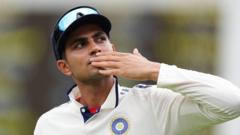Entering the series, India faced significant challenges. With key players like R Ashwin, Rohit Sharma, Virat Kohli, and Mohammed Shami sidelined due to retirements and injuries, the team relied heavily on young captain Shubman Gill. Despite concerns surrounding Gill’s overseas batting record and the fitness of bowling spearhead Jasprit Bumrah, the squad rose to the occasion. Their rocky start, losing the first Test at Headingley, only fueled their drive for a comeback.
The second Test at Edgbaston saw India bounce back spectacularly, claiming victory by 336 runs, a turning point that re-energized their campaign. The series escalated from there, with players from both teams delivering outstanding performances amid fierce competition. Notably, India's batting line-up proved its strength with three players—Gill, KL Rahul, and Ravindra Jadeja—amassing over 500 runs, while England's Joe Root stood alone in this regard. Moreover, India's twelve centuries contrasted sharply with England's nine, and Mohammed Siraj emerged as a key player, leading wicket-taker with a total of 23 dismissals.
Gill’s remarkable performance, echoing Bradman-like statistics with 754 runs, demonstrated his skill, making him a potential batting great. Siraj, too, earned recognition, proving himself as a formidable bowler in Bumrah's absence, inspiring teammates to exceed their limits. His clutch performances at crucial moments sealed victories that ultimately led the series to a dramatic conclusion, reinforcing India’s promise.
This series encapsulates India’s transformation from apprehension to a team brimming with ambition and talent. With their impressive showings, both Gill and Siraj have set a hopeful precedent for the future of Indian cricket. The engaging 56-minute comeback at the Oval will be remembered as one of the most thrilling narratives in Test cricket, highlighting the determination and skills of this young Indian squad.
The second Test at Edgbaston saw India bounce back spectacularly, claiming victory by 336 runs, a turning point that re-energized their campaign. The series escalated from there, with players from both teams delivering outstanding performances amid fierce competition. Notably, India's batting line-up proved its strength with three players—Gill, KL Rahul, and Ravindra Jadeja—amassing over 500 runs, while England's Joe Root stood alone in this regard. Moreover, India's twelve centuries contrasted sharply with England's nine, and Mohammed Siraj emerged as a key player, leading wicket-taker with a total of 23 dismissals.
Gill’s remarkable performance, echoing Bradman-like statistics with 754 runs, demonstrated his skill, making him a potential batting great. Siraj, too, earned recognition, proving himself as a formidable bowler in Bumrah's absence, inspiring teammates to exceed their limits. His clutch performances at crucial moments sealed victories that ultimately led the series to a dramatic conclusion, reinforcing India’s promise.
This series encapsulates India’s transformation from apprehension to a team brimming with ambition and talent. With their impressive showings, both Gill and Siraj have set a hopeful precedent for the future of Indian cricket. The engaging 56-minute comeback at the Oval will be remembered as one of the most thrilling narratives in Test cricket, highlighting the determination and skills of this young Indian squad.




















